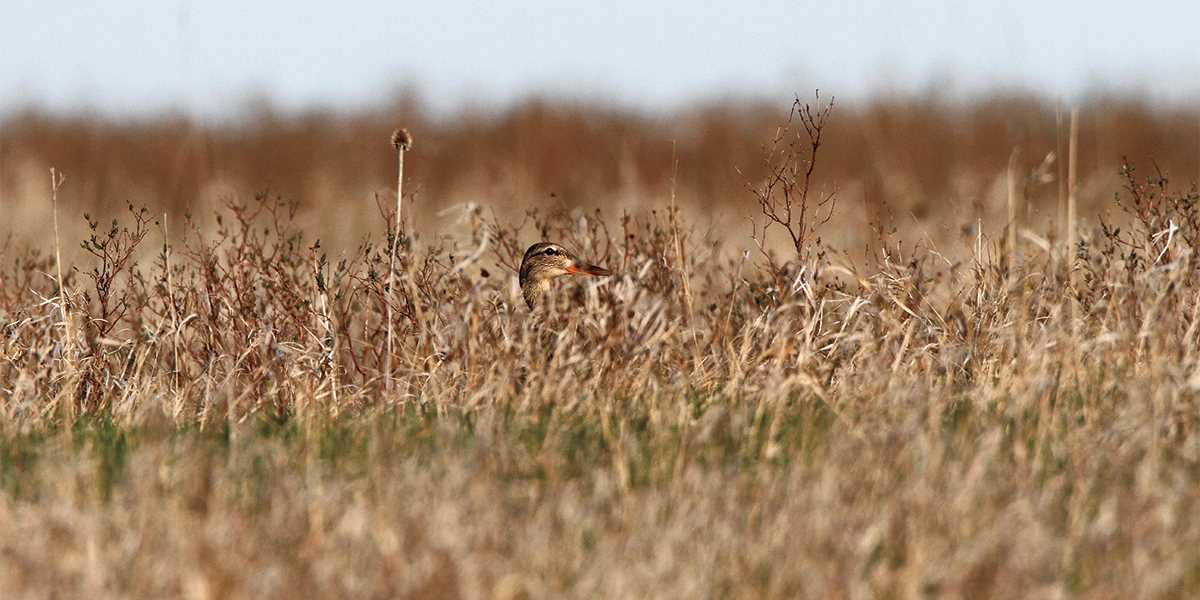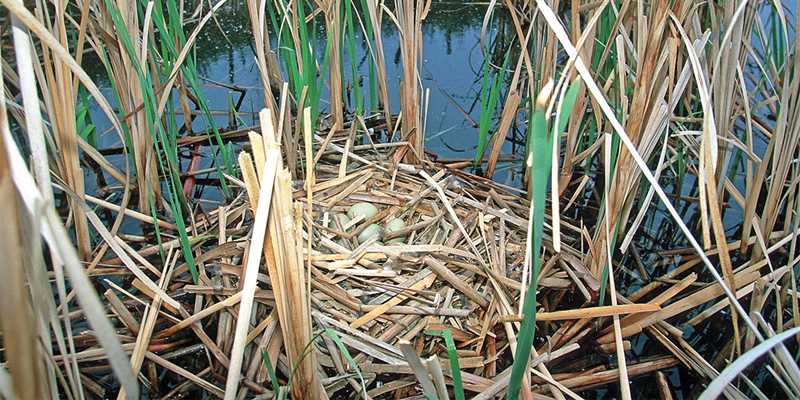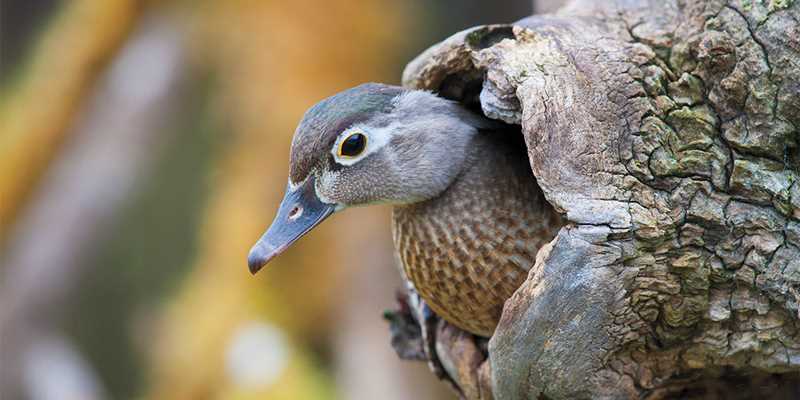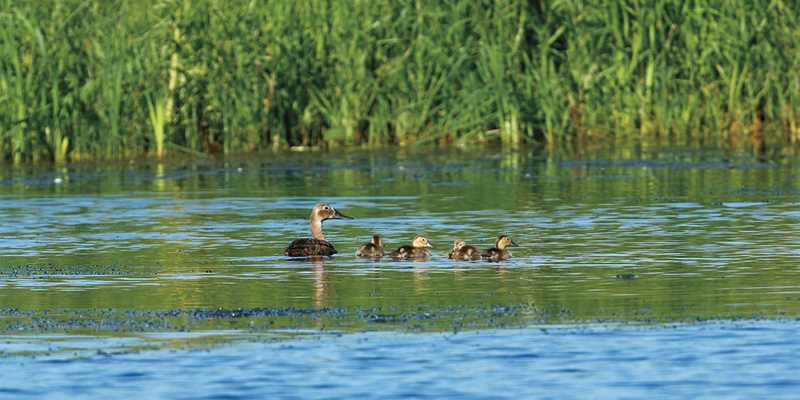Understanding Waterfowl: Duck Nesting Ecology
A fascinating look at waterfowl nest site selection and the behavior of nesting hens
A fascinating look at waterfowl nest site selection and the behavior of nesting hens
By Susan N. Ellis-Felege, PhD.; Kaylan Carrlson; and Tanner Gue

Imagine sitting in your duck blind for hours on end, day after day for almost a month, in conditions ranging from cold rain and wind to hot and humid weather. That is what a nesting female duck does while she is incubating her eggs. Depending on her nesting strategy, the hen will incubate her clutch in upland habitat, over water, or in a tree cavity.
Most dabbling ducks are considered upland-nesting birds and commonly nest in grassland habitat near small wetlands where their mates have established territories. Some diving ducks, such as lesser scaup and white-winged scoters, also nest in upland habitat. The hens' drab coloring, combined with the cryptic construction and placement of their nests, helps conceal their nests from predators. Upland-nesting ducks benefit from large expanses of grass. Research has shown that predation of duck nests is higher in small patches of grassland than in larger blocks of upland cover.

Canvasbacks and many other diving ducks make their nests on floating vegetation over the water.
Where ducks choose to nest in the uplands varies by species. Blue-winged teal, which have much smaller home ranges than other dabbling ducks, typically nest close to the edge of wetlands. In contrast, mallards have much larger home ranges and often nest farther away from water-sometimes up to a mile from the nearest wetland. Diving ducks that may nest in the uplands, such as lesser scaup, have limited mobility on land. Consequently, if they do choose to nest in the uplands, it is typically not far from a wetland.
Many diving ducks make their nests over water on rafts of floating vegetation. This strategy provides a measure of protection from land-based mammalian predators, and many studies have shown that overwater nesters have higher nesting success rates than upland nesters. These species include canvasbacks, ruddy ducks, greater scaup, ring-necked ducks, and redheads. Mallards also occasionally nest over water. While mallards that nest over water typically hatch broods at higher rates than their upland-nesting counterparts, their nests are more likely to be parasitized by female redheads, who regularly lay eggs in the nests of other ducks.
Cavity nesters such as wood ducks, buffleheads, and goldeneyes are also known to parasitize other ducks' nests. These species select nesting sites in tree cavities, which offer protection from the elements and predators. However, the availability of tree cavities for nesting ducks is limited because these sites are usually created by other species, such as woodpeckers, rather than by the hens themselves. This limitation is believed to have led to the strategy of nest parasitism, also known as egg dumping, among cavity-nesting ducks.

Cavity-nesting ducks, like wood ducks, lay large clutches of eggs.
The three different nesting strategies seen among ducks developed over time through the process of natural selection. While upland-nesting waterfowl have lower rates of nest success than overwater or cavity nesters, they are also more likely to renest repeatedly throughout the breeding season. In contrast, overwater nesters don't renest as frequently and tend to avoid breeding altogether during dry years, when their natural protection from land-based predators isn't available. Finally, cavity nesters lay larger clutches (a typical wood duck clutch consists of 12 eggs) than both upland and overwater nesters. Cavity-nesting species are also persistent renesters, presumably to maximize their reproductive potential when limited nesting sites are available.
Although less studied, the behavior of female ducks while nesting has also almost certainly evolved through natural selection and is an integral part of the success of their overall nesting strategies. To conceal the location of their nests from potential predators, hens rarely leave the nest during incubation, and when they do, it is only for relatively short periods of time. Research conducted by Ducks Unlimited in partnership with the University of North Dakota has found that female blue-winged teal leave the nest only about twice a day, with each nesting break lasting an hour and a half on average. This same research revealed that mallards leave the nest less often, only about once a day, but their time away from the nest is slightly longer-roughly two hours on average.
Whether it's an upland-nesting mallard in central North Dakota, an overwater-nesting canvasback in southern Saskatchewan, or a cavity-nesting bufflehead in northern Alberta, female ducks require important food resources for clutch formation, incubation, and brood rearing. Most of these resources are found in wetlands. That's why conserving wetlands and other crucial nesting habitat on the prairies and in other important waterfowl breeding areas is among Ducks Unlimited's highest priorities. To accomplish this objective, DU works with a variety of conservation partners-including farmers and ranchers-to conserve, enhance, and restore these vital habitats on diverse landscapes across the continent.

Dr. Susan N. Ellis-Felege is an associate professor of wildlife ecology and management at the University of North Dakota. Kaylan Carrlson is manager of conservation planning and Tanner Gue is a biologist in DU's Great Plains Region.
Ducks Unlimited uses cookies to enhance your browsing experience, optimize site functionality, analyze traffic, and deliver personalized advertising through third parties. By continuing to use this site, you agree to our use of cookies. View Privacy Policy